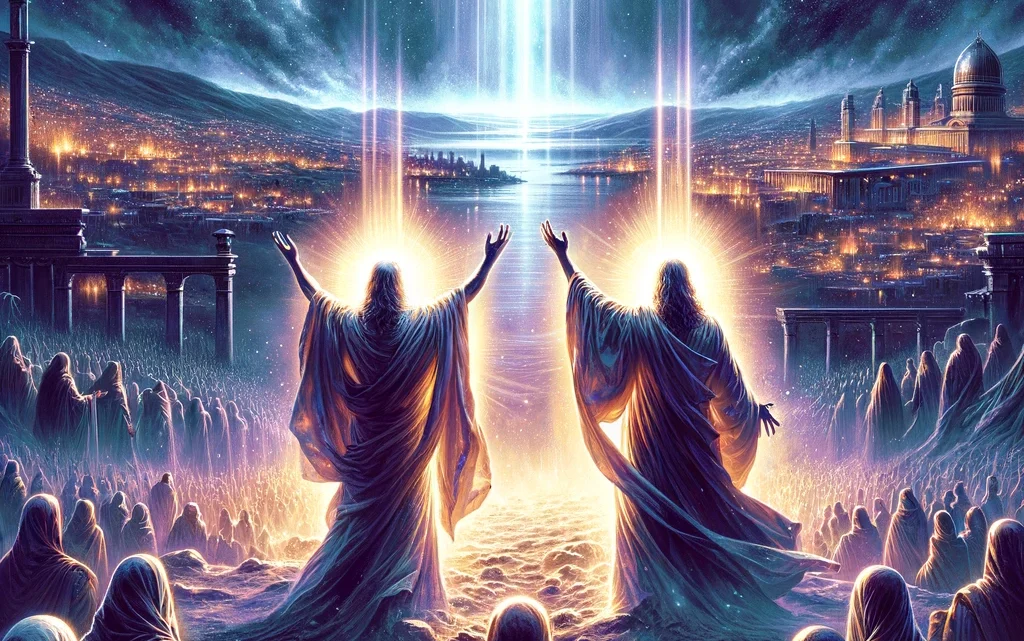“Who Are the Two Prophets? Unraveling the Mystery of the Olive Trees and Lampstands”


In the prophetic landscape of the Bible, the imagery of two olive trees and two lampstands emerges as a compelling enigma, pointing toward two figures shrouded in mystery and power. These symbols, deeply entrenched in the scriptures, offer clues to the identity and mission of the two prophets described in the Book of Revelation and their connection to the broader narrative of God’s redemptive plan.
The Prophetic Identity: Olive Trees and Lampstands
The Book of Revelation introduces us to two witnesses, described as “the two olive trees and the two lampstands that stand before the Lord of the earth” (Revelation 11:4). This imagery is not new but is deeply rooted in the Hebrew Scriptures, particularly in Zechariah 4, which depicts a golden lampstand flanked by two olive trees. These trees supply oil directly to the lampstand, symbolizing the continuous outpouring of the Holy Spirit, empowering God’s messengers to shine His light in a world ensnared by darkness.
The Unity of Judah and Israel: The Two Sticks
Ezekiel 37:15-28 introduces another compelling piece of the puzzle: the prophecy of the two sticks. God commands Ezekiel to take two sticks, writing “For Judah” on one and “For Joseph (Ephraim)” on the other, and then to join them together as one. This symbolic act foretells the eventual reunification of the divided kingdoms of Israel and Judah, illustrating God’s promise to restore His people under one shepherd.
The connection between the two olive trees, the lampstands, and the two sticks of Ezekiel paints a picture of unity and reconciliation. It suggests that the two prophets embody the collective spirit and purpose of God’s chosen people, bridging the divisions of the past to stand as a united front in the face of the world’s darkness.
The Mission and Fate of the Prophets
Clothed in sackcloth, the two prophets are granted authority to prophesy for 1,260 days, bearing witness to God’s sovereignty and impending judgment. Endowed with the power to perform miracles reminiscent of Moses and Elijah, their ministry challenges the rebelliousness of the world, even as it offers a call to repentance.
Their confrontation with the beast from the abyss marks the climax of their earthly ministry. Overpowered and killed, their bodies lie unburied in Jerusalem’s streets, in what seems like a moment of triumph for evil. Yet, this apparent defeat is overturned when God resurrects them, their ascension to heaven a vivid testament to the power of God and the imperishable nature of His truth.
Reflections on the Identity and Purpose
The two prophets, symbolized by the olive trees and lampstands and linked to the united legacy of Judah and Israel, stand as a beacon of hope and a reminder of God’s faithfulness. They embody the resilience of God’s people and the power of divine testimony in a world that often rejects the light of truth.
Their story is not just one of ancient prophecy but resonates with the enduring call for God’s people to be lights in the darkness, united in purpose, and sustained by the Holy Spirit. As we reflect on their mission, we are reminded of the ultimate victory of God’s kingdom, the promise of restoration, and the power of prophetic witness in bringing about divine purposes.
In the end, the two prophets’ identity transcends individuality, encapsulating the collective mission of God’s people to bear witness to His truth and light. Their legacy is a call to each of us to stand firm in our faith, empowered by the Holy Spirit, as we await the fulfillment of God’s redemptive plan.

